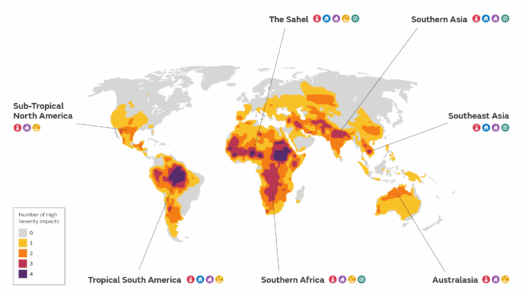The Indian monsoon, a vital meteorological phenomenon, plays an indispensable role in sustaining the ecosystem and agricultural practices of the subcontinent. However, global warming presents an imminent threat to the stability and predictability of this seasonal weather pattern. The impact of climate change on the monsoon is a multifaceted issue, intertwining environmental consequences with socio-economic ramifications that are critical to comprehend.
At its core, the monsoon is characterized by a complex interplay of atmospheric dynamics, ocean temperatures, and humidity levels. Typically, the Indian subcontinent experiences this annual rainfall from June to September, ushering in respite from the sweltering summer heat. It is the lifeblood for millions of farmers, providing the necessary moisture for crops such as rice, wheat, and pulses. The monsoon cycle is not merely a weather event; it is a cultural and economic keystone that governs agricultural cycles, water supplies, and local economies.
However, anthropogenic climate change is influencing the monsoon’s behavior, leading to a plethora of alterations that could be devastating. Projections indicate that rising global temperatures are likely to exacerbate the variability, intensity, and timing of monsoon rains. Studies have shown that with each degree Celsius increase in global temperature, the monsoon could become more erratic, potentially leading to prolonged droughts interspersed with episodes of extreme rainfall.
One of the most concerning aspects of climate change is its potential to increase the intensity of rainfall. While abundant rainfall is critical for replenishing water bodies and ensuring agricultural productivity, extreme downpours can result in catastrophic flooding. Coastal cities and rural areas alike may suffer significant floods, leading to displacement of communities, destruction of infrastructure, and increased mortality rates. The deleterious impact on agriculture due to sudden and intense rains can catalyze crop failures and cause long-term economic distress for farmers who depend on predictable rain patterns.
In addition to increased intensity, the monsoon’s onset and withdrawal phases could also be disrupted. Climate models suggest that the rainy season may start later than usual, and the cessation of rains might occur prematurely. A delayed monsoon can adversely affect sowing seasons, leading to lower yields and undermining food security. Such unpredictability not only places stress on farmers but also affects the livelihood of millions dependent on the agricultural sector.
Moreover, the geographical distribution of rainfall is becoming uneven. Certain regions may experience surplus rainfall while others suffer from deficit, compounding existing inequalities in water resource availability. Areas that are already arid may face escalating water scarcity, creating a vicious cycle of drought and food insecurity. Conversely, regions historically accustomed to milder summers and manageable rainfall patterns may find themselves in the throes of severe flooding, appealing for urgent and strategic adaptation measures.
The implications of these changes ripple outward, impacting not just agriculture but also biodiversity. Unique ecosystems that rely on the regularity of the monsoon may face unprecedented stress. Aquatic habitats, transformed by altered rainfall patterns, could endanger fish populations and disrupt the food chain. Terrestrial flora and fauna may also struggle to adapt to rapid environmental changes, risking extinction for numerous species, particularly those with limited mobility or specialized habitat needs.
Furthermore, these shifts have socio-political implications that cannot be overlooked. The potential for resource-related conflicts may rise, as communities compete for dwindling water supplies and arable land. Vulnerable populations, particularly marginalized farmers and women, could be disproportionately affected, exacerbating social inequalities and leading to humanitarian crises. Governance frameworks will need to evolve to address these impending challenges, with policies focused not just on immediate relief but on long-term resilience building.
Efforts to mitigate the impact of climate change on the monsoon demand a multi-stakeholder approach. Enhanced research and monitoring systems are essential to improve weather forecasting and climate modeling capabilities. Innovations in agricultural practices, such as crop diversification and rainwater harvesting, could also bolster food security and resilience against climate variability.
Additionally, investment in infrastructure to withstand extreme weather events is vital. Improved drainage systems, flood control measures, and sustainable urban planning can help communities adapt to the realities of altered monsoon patterns. Governments must prioritize climate adaptation strategies that empower local communities and engage them in decision-making processes concerning resource management.
On a global scale, international cooperation is crucial for addressing the root causes of climate change. Nations must commit to reducing greenhouse gas emissions and transitioning to renewable energy sources to alleviate some of the pressures facing the monsoon. Climate finance should be allocated to support vulnerable countries as they grapple with the realities of a warming world.
The Indian monsoon is inextricably tied to the region’s ecological balance and socio-economic stability. Understanding its vulnerability in the context of climate change is imperative. As stakeholders across various sectors mobilize to address these challenges, the hope remains that collaborative efforts can make a difference, ensuring that future generations will continue to benefit from the life-giving rains of the monsoon season.







